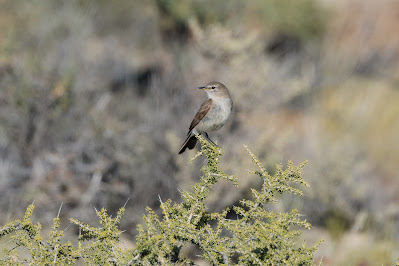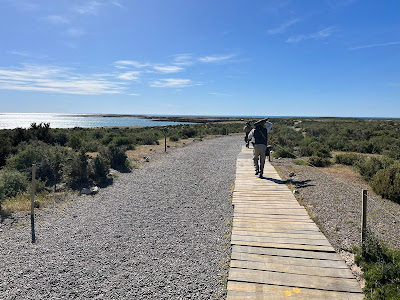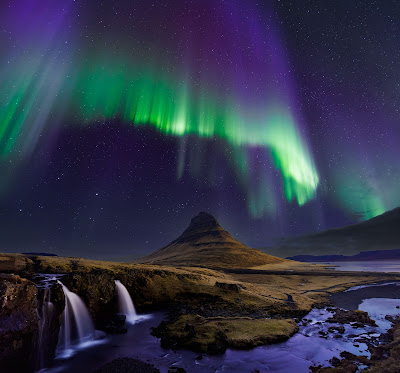Oct 30
Today's weather was forecast to be dreadful from a birder's perspective and somehow managed to be even worse than predicted. Sustained 30-35mph winds meant that whale watch boats would be canceled, and finding passerines would be like pulling teeth. So we decided to not set an alarm for the morning and recuperated a bit. The afternoon would be spent on the Valdes Peninsula.
The skies were mostly clear until we reached the base of the peninsula where we hit some precipitation. For the next several hours we dealt with squalls that brought rain, sleet, and truly impressive wind gusts. Standing upright became difficult when these weather waves rolled through. Between the squalls were sunny skies but still difficult wind. To be honest, searching for wildlife of any kind seemed entirely futile. Not even the large mammals like guanacos were visible; they too must have been hunkered down in the lee. Through the car windows we managed to spot a grounded RUSTY-BACKED MONJITA and a few TWO-BANDED PLOVERS, but that was about it.
As one might imagine in these conditions, the peninsula was mostly void of visitors, even though this was a spring weekend during Southern Right Whale season. While attempting to bird along the main perimeter road, a kind passerby asked us if we were alright. Slightly puzzled, he offered "You know you have a flat tire, right?" No we did not. We still don't know when it happened, but the tire was completely out of air.
 |
| Common Miner about to enter its burrow as we changed a flat tire |
We knew where to find the jack and tire because we'd made sure that we had all tire-changing gear before we left Buenos Aires. So the exchange went smoothly and we leapt back into the car just as the skies opened for another downpour.
As we neared the outer coast DP somehow noticed the head of a DARWIN'S NOTHURA sticking above the blowing grasses. I'm still not sure how he picked it out. After encountering many Spotted Nothuras to the north, this was the only Darwin's we would see all trip.
At 4pm we reached Punta Cantor just as there were signs the wind might let up. There was no sign of rain at this point. Here we would conduct a seawatch. As soon as we glimpsed the ocean DP spotted a skua moving southward. Photos revealed it to be a BROWN SKUA, apparently a bird of the expected Falkland Island subspecies.
 |
| "Falkland" Brown Skua |
The outer Valdes Peninsula is known to be an excellent place to view both mammals and birds. A few male ELEPHANT SEALS were hauled out, and further up the coast we could see dozens more.
 |
| Elephant Seal |
Down the trail we found a lee from which we could watch the water in comfortable fashion with the sun at our backs. Fantastic scope views of both GIANT-PETRELS were had. A second SKUA made a close pass, this one also a Brown. Our first penguins, MAGELLANIC, were spotted in the water. Gulls and terns fed offshore, and a pair of FLYING STEAMER-DUCKS kept shelter in the shallows.
 |
| Southern Giant-Petrel |
 |
| Northern Giant-Petrel (note the reddish bill tip) |
The peninsula is a world famous place to view Orcas, especially in March-April when they literally pick sea lion pups off the beach! We were not lucky enough to see any, but friend Tom Johnson and his group observed Orcas in the shallows here about a week later.
By the time we left our watch, the wind had come down considerably, the sun was shining brightly, and suddenly the land birds and mammals came out of hiding. The golden light, the sweeping landscape and the backdrop of the sea combined for a gorgeous setting to enjoy all the Valdes Peninsula had to offer.
 |
| Rufous-collared Sparrow |
 |
| Patagonian Mockingbird |
 |
| Large Hairy Armadillo |
 |
| Large Hairy Armadillo |
 |
| Guanacos |
 |
| Guanacos |
 |
| domestic sheep |
 |
| Guanacos |
 |
| Patagonian Mara |
 |
| Patagonian Mara |
GUANACOS were everywhere all at once. The peculiar PATAGONIAN MARA made a few appearances. LESSER RHEAS were finally found. Small parties of ELEGANT CRESTED-TINAMOU crossed the roads with reckless abandon. We accidentally flushed one off its roadside nest and were amazed to see a bundle of mirror-like emerald green eggs.
 |
| Elegant Crested-Tinamou |
 |
| Elegant Crested-Tinamou nest |
The day's constant crosswinds had taken a toll on our vehicle's fuel economy, and we just about rolled into the gas station at Puerto Piramides on fumes. We enjoyed a fantastic dinner there and returned to Puerto Madryn.
Oct 31
This morning we spent a few hours along the coast east of Puerto Madryn as far as Cerro Avanzado. We found two new flycatchers, neither of which we were expecting at this location: SPOT-BILLED GROUND-TYRANT and WHITE-WINGED BLACK-TYRANT. My personal highlight of the morning was another experience viewing SOUTHERN RIGHT WHALES, this time a bit closer and for a longer period of time than the other day.
 |
| Patagonian Mockingbird |
 |
| Spot-billed Ground-Tyrant |
 |
| Diuca Finch with nesting material |
 |
| White-winged Black-Tyrant |
Since we had done so well in the preceding days, leaving very little on the bone, we again found ourselves a bit ahead of schedule. This was ideal because we really wanted to repair or replace our damaged tire in case we got stuck with another flat. We set off for Trelew, arrived late morning, and found a tire shop straight away that was able to fix the damage rather quickly!
Laguna Chiquichano, located across the street from the tire shop, seemed too convenient to ignore. Loaded with birds, Tripp got his waterfowl fix for the week. Diversity wasn't amazing, but the views were solid. Triple-digit counts of RED SHOVELER and LAKE DUCK were impressive, and we finally found our first SILVERY GREBES of the tour.
This afternoon, in the absence of important plans, we decided to head east towards Rawson and act on a couple random eBird leads for Least Seedsnipe and Tawny-throated Dotterel, both major trip targets. Sadly the pins were dead ends on private land and we had little to show for our efforts other than a bunch more SILVERY GREBES. Things got a bit interesting on our drive back to Trelew when traffic suddenly came to a standstill heading out of Rawson. We deftly maneuvered our way to another artery out of town only to find the same completely still traffic jam. I messaged our Airbnb host who informed us that this was the result of a coordinated political protest. Such disruptions have become more common in recent months as Argentina's economy continues to slide in the face of political corruption. After a couple hours of sitting around, the cars began to slowly move. By the time we reached the site of blockade, the flaming tires had been removed from the roadway and the protestors had either scattered or been arrested or some combination of the two!
At this point, after a mostly wasted afternoon, we called it a day. Luckily, since we had been a bit ahead of schedule, this was nothing more than an inconvenience for us.
Nov 1
Our final day on the road would be an active one! The plan was to drive south to Punta Tombo and back, birding en route, before our afternoon flight to Ushuaia.
We set out very early and made sure we were at our first roadside stop for sunrise. One of the first sounds we heard getting out of the car was that of singing LEAST SEEDSNIPE. Two pairs seemed to be sharing the area around this water hole. They were not very approachable, but scope views were excellent. A RUSTY-BACKED MONJITA made a brief appearance on the fence line.
 |
| Rusty-backed Monjita |
 |
| Least Seedsnipe habitat |
A passerine species that had eluded us to this point was BAND-TAILED EARTHCREEPER. We had tried a few spots further north, but we were now getting into more favorable territory. Our first couple stops this morning were fruitless, but persistence paid off and we finally found a spot that held three of them.
 |
| Band-tailed Earthcreeper |
 |
| Variable Hawk |
As we approached Punta Tombo we passed a small ranch with lush vegetation and a water source, so no surprise that it was birdy. New for us were GRAY-HOODED SIERRA FINCH and BLACK-CHINNED SISKIN, plus quality repeats like WHITE-TIPPED PLANTCUTTER, WHITE-WINGED BLACK-TYRANT, SCALE-THROATED EARTHCREEPER and CHIGUANCO THRUSH.
 |
| Tripp in action |
At the reserve itself there are two main parking areas, one for ticket purchases and one for trail access. We were greeted at both lots by more GRAY-HOODED SIERRA FINCHES that were literally picking insects off cars and scavenging scraps by the restaurant.
 |
| Gray-hooded Sierra Finch longingly peeking into the restaurant |
The MAGELLANIC PENGUIN colony at Punta Tombo is a major tourist magnet. We're talking bus tours and the like. The key is to get in early before the hoardes arrive. While we weren't quite there for opening, we were one of the first to arrive and had the path largely to ourselves for a while. The sun was already high and harsh, which made photography difficult, but the experience was still very enjoyable. The penguins are scattered though a large area, some of which are quite close to the trail. These are charming birds and it is absolutely worth the trip to see them.








The A-#1 bird target here was actually the endemic WHITE-HEADED STEAMER-DUCK, which we found without any trouble. We had nice scope views of a male from the first lookout point, plus another few further out. Luckily we had scored those Brown Skuas at the Valdes Peninsula, so we did not have to continue further to look for that species...which was a good thing because the harsh light would not have made skua identification terribly easy.
 |
| scoping steamer-ducks |
 |
| Kelp Gull devouring a Penguin egg |
We then boogied back to Trelew, not having to stop for anything along the way thanks to our successful morning. We gave ourselves enough time to return to Laguna Chiquichano while we repacked our luggage and headed to the airport.
 |
| Red Shoveler |
 |
| Lake Duck |
 |
| Red Shoveler |
 |
| White-tufted Grebe |
The whirlwind road trip had come to an end, and to be honest it couldn't have worked out much better. A couple tough species gave us the miss early on (Dot-winged Crake and Stripe-backed Bittern), but otherwise we nearly swept all of our target birds and logged some excellent mammals as well.
We were excited to move on to the next leg of the trip. Our 800 mile flight to Ushuaia was uneventful and got us there before dark. The views of the southern Andes were spectacular from the air. Though the urge to hit the ground running was strong, we only took a quick glance at some habitat by the airport before checking into our Airbnb and grabbing empanadas for dinner.
- NB














































Comments
Post a Comment